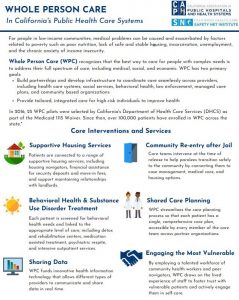For many people in low-income communities, health problems can be caused and exacerbated by a range of factors related to poverty, which may include poor nutrition, lack of safe and stable housing, incarceration, unemployment, and the chronic anxiety of income insecurity.
 Whole Person Care (WPC), a pilot program by the California Department of Health Care Services (DHCS), attempts to bridge gaps in care for patients with complex health and social needs. WPC has two primary goals – to provide high-risk patients with tailored, integrated care and to build the local partnerships and infrastructure to strengthen care coordination across providers. For many health systems, this is a big endeavor. Although, services to alleviate stress and inequities may be available in their communities, they are often delivered in a siloed fashion, where different types of service providers do not regularly communicate or coordinate care, even though they may be serving the same individuals and families.
Whole Person Care (WPC), a pilot program by the California Department of Health Care Services (DHCS), attempts to bridge gaps in care for patients with complex health and social needs. WPC has two primary goals – to provide high-risk patients with tailored, integrated care and to build the local partnerships and infrastructure to strengthen care coordination across providers. For many health systems, this is a big endeavor. Although, services to alleviate stress and inequities may be available in their communities, they are often delivered in a siloed fashion, where different types of service providers do not regularly communicate or coordinate care, even though they may be serving the same individuals and families.
WPC pilots bring together public health systems, social services, behavioral health, law enforcement, managed care plans, and community-based organizations to provide wrap-around services for the most vulnerable individuals in their communities. Since the program rolled-out in 2016, over 100,000 patients have been enrolled across California.
In the first year of the program, 75% of WPC pilots opened or expanded post-acute facilities and/or temporary housing, including medical and psychiatric respite centers, low-threshold homeless shelters with on-site intensive care management, and transitional housing units.
Pilots are also developing new innovative ways to reach individuals in need. For example, Ventura County designed “one stop” mobile care pods at homeless encampments. Kern County is partnering with local law enforcement to ensure parolees are connected to a patient-centered medical home upon release, and Los Angeles County employed hundreds of community health workers, who often have shared lived experiences with WPC patients, to serve as key members of the care team.
Interested to learn more? Read this brief summary with early program successes, including individual highlights from each public health care system participating in the pilot.